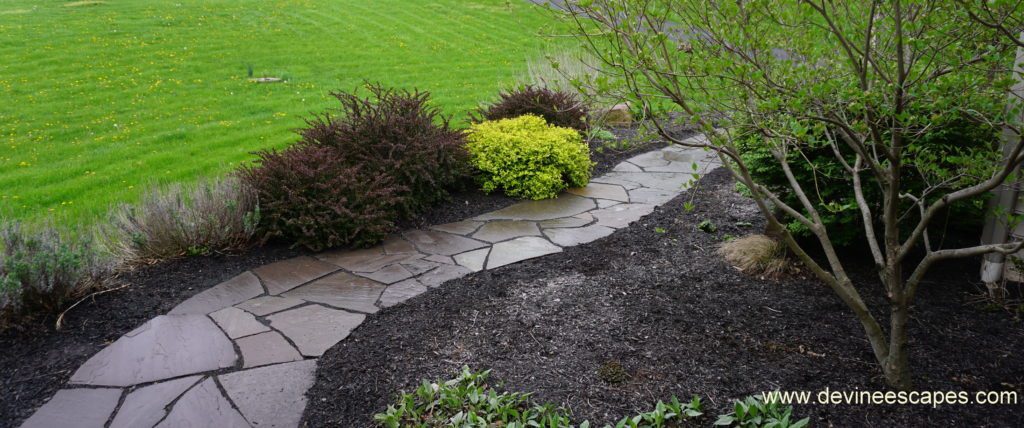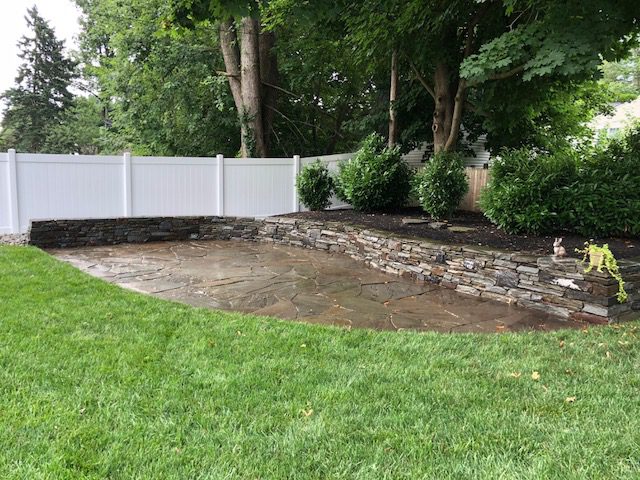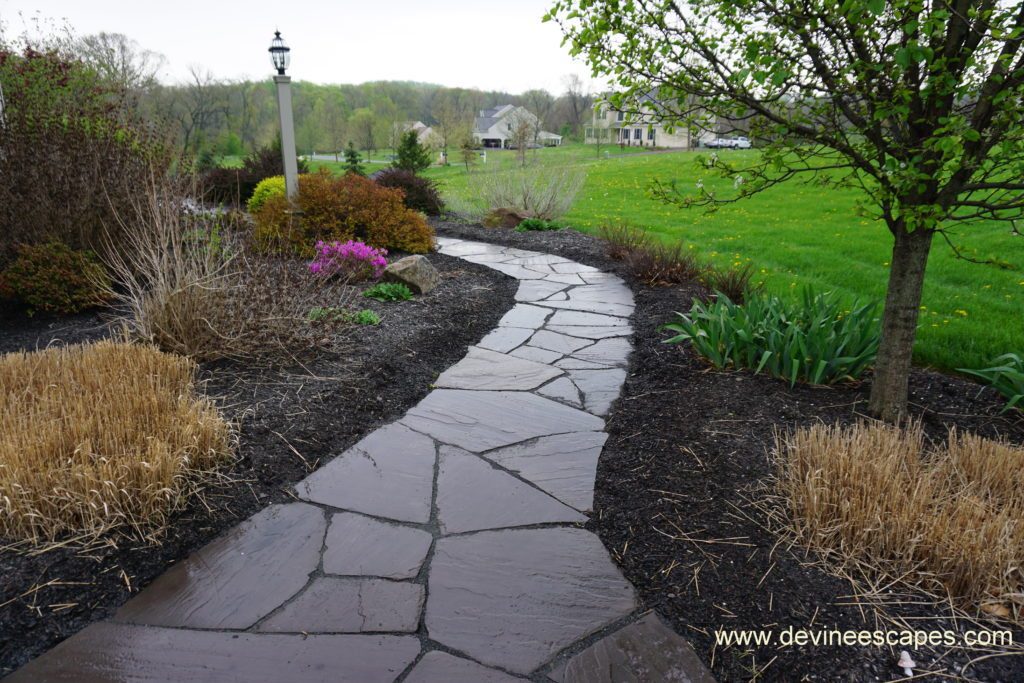Devine Escapes
hardscape contractor in Blakeslee PA
devin@devineescapes.com
Do you use landscape fabric under stone patios?
Here’s a common question about how to build a stone patio, that I haven’t addressed in any of my DIY articles yet–do you need fabric under your flagstone pavers? Actually, it’s a series of questions:
- should you put fabric underneath your flagstone pavers?
- if so, where do you put it/how do you install the fabric?
- will putting landscape fabric beneath your flagstone stop weeds?
- what type of landscape fabric should you use beneath your flagstones?
- Do you use landscape fabric in gardens or lawns to stop weeds?
Quick answer: no, landscape fabric will not prevent weeds in your stone patio–but there may be other reasons to consider using landscape fabric beneath your stone patio. Usually, you’re fine without it, except for some special cases. Read on! The above bullet points are each answered in turn, below.
phone consultations | personalized instruction
DIY hardscape/masonry/flagstone help rates:
$123.00 for one hour
$80 for a half hour
Monies are payable via Venmo (preferred) paypal or zelle
Related content: Need individual guidance for your flagstone installation? DIY phone consultations available.
landscape fabric under stone patios– and weeds
landscape fabric will not stop weeds, ever, do not ever use it for that purpose
There’s at least one international concrete paver institute out there, who offers a 2-day certification course and teaches everyone that we should lay a geo-textile fabric underneath our gravel, when installing hardscape paver units. Back when I took such a course they were recommending that contractors use, more specifically a “woven, geotextile fabric” on top of compacted sub-grade/underneath the gravel that is to be compacted.
Now I took that test eighteen years ago, back when concrete pavers ruled the world and hardly anyone even remembered what flagstone, or natural stone of any type, even was. In 2007 I started my own business, Devine Escapes, specializing in natural stone and eschewing all concrete pavers, stamped concrete, fake veneer, and all other faux stone products. Let’s just keep it real, okay? As the years have gone by, the public has likewise had a bit of a backlash against all the faux, fake, ersatz and pseudo hardscape products out there–more and more homeowners have been asking your hardscape contractors for real stone. Like back in the olden times! But with modern sensibility, right….like 10 years after I started leading this charge, now I see people calling it “rustic chic”.
Related content: No plastic in the landscape

I used to call it, “natural materials, built to traditional standards, with an eye for artistic form and fine detail”. (old slogan of mine).
But you see, all these guys who learned how to do concrete pavers, and have only recently begun doing natural stone, they are all just using the same methods as they used for pavers….and applying it to stone. There are similarities to concrete paver installation and flagstone installation–but there’s important differences too.
Related content: how to install dry laid flagstone
should you put landscape fabric under stone patios? In most cases, the answer is “no”
But on those occasions when you will want to use fabric, this is the stuff you want.
I used to use fabric, always, on every single flagstone installation (whereas these days, I use geotextile fabric underneath maybe half of my stone patios) And I used to use fabric and gravel behind my dry stone walls….after learning that pouring gravel behind a dry stone wall and then covering it with fabric might not be the best idea (it’s really not) then I began to question the need for fabric beneath my flagstone as well.
Of course the thing about preventing weeds has already been debunked. Aside from that, there are two structural justifications for using fabric beneath your gravel foundations:
- use landscape fabric/geotextile fabric to stabilize the soil
- prevent transmigration of soils
Stabilize the soil
Okay, so you dig down 7 to 10 inches (depending). Compact the sub-soil, which is usually clay. Lay fabric. Then lay gravel, then tamp that gravel. Then set your flagstones out–first the puzzle, then once all the flagstone’s been puzzled out, you level them up one stone at a time upon a bed of stone dust (screenings, decomposed granite, 8th inch minus, quarry fines–stone dust goes by many names, depending on your location).
The subsoil may shift slightly, over the years, sinking and or heaving. You don’t want that–that’s why you dig down and compact the soil–making sure there’s no roots or other organic matter down there, and then compact the gravel. Both the clay and the gravel can and will move, slightly. So will concrete mind you–just when the concrete moves, it cracks. So stabilizing the soil here means that the weight is spread out. the fabric is all spread out….picture a 100 pound object set atop clay soil. The object might only be 1 foot wide. It may sink, over time on that clay soil, right? Well, what if you lay a piece of plywood out on that soil, then put your hundred pound statue of liberty reproduction, or garden gnome, or whatever down on top of that plywood. Less likely to sink, right?
That’s what the fabric does. The weight is spread out. In fact, I’ve seen so many patios that did NOT have fabric beneath them, yet 10 years later they still look great. I’ve seen other flagstone patios that DO have fabric beneath them–and seen them need maintenance. Look, I’ve been doing this for some time now and from what I’ve seen so far, I can not state that the addition of fabric will make any real difference as to whether or not the flagstone patio will need maintenance down the road.
Compact the sub soil, pitch everything right, compact your gravel, use enough gravel for the particular site, use appropriate sized flagstones, just overall know what your doing and try your best–and the flagstone will still sit nice and level years and years later. You might need to re-level a couple of stones, slightly over the years. In my experience, that is rare, rare, rare. I’ll check in with clients from years ago and they tell me, “nope! no maintenance needed!”

10 years later….no stones have shifted, no maintenance needed (other than topping off the stone dust once a year and power washing once every five years or so)
Where do you put it/how do you install landscape fabric under stone patios?
Between the soil and the gravel.
In addition to (theoretically) spreading out the weight and thereby minimizing the movement of soils, using the fabric also allegedly stops “transmigration of soils”.
Okay, I’m a bit skeptical of the second part. Transmigration of soils is supposed to be little bits of stone dust and gravel sinking down from your gravel bed and into the clay. Nope–I’m not buying it. Soil is compacted, gravel is compacted–any so called (let’s try and say this with a straight face, not a sour incredulous grimace) “transmigration of soils” is going to be so minimal as to be far beneath our notice or concern.

will putting landscape fabric under stone patios stop weeds?
Well, think about it. Your flagstone is what, inch and a half or two inches thick, with stone dust in the joint…..Then you’ve got what, an inch of stone dust underneath your flagstone and then 4 to 6 inches of compacted gravel. Any weed whose root makes it that far down, all the way down to your fabric–any weed like that is going to laugh at your geotextile fabric. Think tap-root. Think dandelion.
Even if the root can’t bust through the fabric, it still is embedded in 8 inches or so of gravel. It’s in there already!
So the answer is a resounding NO, landscape fabric will not stop weeds in your patio, walkway, flagstone nor pavers.
Okay, but why not put the fabric on top of the gravel, underneath your stone dust?
Okay, first off, you just can’t put the fabric right under the stone–the stone will rip it. So maybe underneath the stone dust?
Problem there is that first you have to puzzle out your flagstones–so you’d have to lay out your gravel, compact that, then lay out fabric–then puzzle out all them stones–right on top of the fabric. You’ll rip it all up.
Even if you could put the fabric inbetween the gravel and stone dust–your weed roots would still have to make it past an inch and a half of stone dust filled flagstone joint, plus through an inch or so of stone dust leveling bed–so that weed would be a) able to live on stone dust, with no actual topsoil or clay soil in sight or b) won’t mind busting through that fabric.

Bonus: how to cut flagstone using just a hammer:
landscape fabric under stone patios–what type of fabric should you use?
Filter fabric. Non-woven geotextile filter fabric. Just call your local hardscape supplier and ask for “the felt stuff”. It looks and feels like felt–and it allows water to pass through. Some woven fabrics, plastic landscape fabrics won’t let water pass through very easily, some fabrics sold as weed fabric will do the same. Go with felt–IF you choose to use fabric.
landscape fabric and spongey clay soil
So here’s one use for fabric–say you go to build a hardscape, you dig down, then you go to tamp–and the clay soil does not tamp properly, becomes spongy feeling. Step down, and it’s like walking on a water bed. You don’t want to build on that kind of base. But it’s time to lay gravel and get it down, right?
In that circumstance, the more you tamp, the more water from below gets brought up. It just gets spongier. So you can wait for the sun to dry it out–might take days. Hopefully it doesn’t rain while you’re waiting! Or dig down deeper and just use more gravel? Might work…if you go a lot deeper and use a lot more gravel.
Here’s how you do it:
using landscape fabric to stabilize spongy subsoil
- Dig down a bit deeper. If you were going to have 6 inches of gravel, make it more like 10.
- LIGHTLY compact the subsoil, using a hand tamper not a plate compactor and certainly not a jumping jack. If soil is sticky clay, add just a bit of gravel to that soil before tamping–now your tamper won’t get covered in heavy clay. That’s another pro tip for you and you are welcome.
- Lay out your non-woven geotextile felt-type fabric.
- Spread out a few inches of gravel.
- Lightly hand-tamp.
- Put down another layer of fabric, lightly tamp again. At each lift, the camp acted base should become less and less spongey.
- Another few inches of gravel, then fabric, then tamp–repeating until you bring it up to the right height. Now step there again and guess what? It feels solid underfoot–no more waterbed effect.
- How much does the fabric actually help? I’m not sure! Maybe it’s more about the few-inch-lifts of gravel and the light tamping. I DO know however that this technique holds up, over years. Having encountered spongey subsoil on many many properties, AMD then used this technique to deal with the situation–visiting the same properties ten years later and they have held up quite well.
Essential tools needed for flagstone installation:
- https://amzn.to/3AxXV4i wood handled brick hammer. Happens to cost less than steel….but I prefer wood, less jarring on the elbow.
- https://amzn.to/3tXYMsR Dead blow mallet.
- https://amzn.to/3ksajx9 Angle grinder. Same one I use.
- https://amzn.to/2VYb8Ey Blades.
- https://amzn.to/3hU8hoa Brick chisel.
- https://amzn.to/3ktol1G Grabo. Not cheap, but it will save your finger tips from having to pry up heavy stones. Worth it, if you plan on laying more than 200 square feet (or so) of flagstone.
- A couple of 5 gallon buckets (for stone dust, when leveling stones)….shovel, wheel barrow…..4′ level
- https://amzn.to/3hWi0tR Pick maddock. Best way to dig. Break up soil with this, then use shovel.
- https://amzn.to/3lFjfPi Knee pads–essential.
So when should you use landscape fabric under stone patios? When should you not use it?
Well if in doubt use it, it can’t hurt, right? It does cost money and all things we produce do have an environmental impact AND professional opinion states that most flagstone patios will be fine without the fabric–and at most, my usage of such fabric has maybe saved a few of my clients a small, small amount of maintenance. So maybe I didn’t have to return to re-level 2 stones on a thousand square foot patio. Heck, that fabric costs about the same as the bill for such a small bit of maintenance would cost. They’re both nominal expenses.
- If you know the soil is stable–if the soil has not been disturbed in 10 years, it’s probably stable. If an old patio sat there for years…..probably stable. No need for fabric.
- If the area is prone to flooding…might not be stable. Use fabric. If the house was just built a few years ago, that soil might not be stable, again– you might want to use fabric.
What we can reasonably assume, from the spongy soil example above, is that the fabric actually CAN stabilize soils which are prone to movement. As such, if you’re working on recently disturbed soils, from new construction, or in a place that may flood–then you pribably want to dig deeper, use more gravel, and/or use a bit of filter fabric.
On the eco-tip
True, both the gravel production and fabric production do involve some environmental impact. Then again….if you build a poor flagstone patio and it needs to be re-built–that will have even more negative impact. Let’s take our time and build beautiful structures that last and last.
related articles:
- DIY consultation services (one on one time with a professional hardscape contractor)
- polymeric sand between flagstone pavers? (spoiler–it’s a bad idea)
- vacuum lifter for lifting stone slabs
- how to build dry stone walls (nope, they do not need fabric behind them either)


I have been reading a lot about the way you install flagstone patios. It all makes a lot of sense! I am installing a small flagstone patio in our front landscape. The shape is somewhat oval and is roughly 11′ x 8.5′. So far, I have:
*Excavated 7-8″ of the area
*Compacted the clay
*Staked the area for the slope I want
*Back filled the cavity with 4″ of #53 limestone with dust
*Compacted the limestone and dust
*Next…
I am ready to spread the the top layer with 1-2″ of decomposed granite as I have read you recommend. A local supplier offers 3/8″-0″ decomposed granite. I went to the supplier’s location to check out their product and found the largest pieces to be 1/2″ or so long. The product ranges from granite dust to the 1/2″ pieces mentioned. So, are these 1/2″ chunks too large to use as my top layer base? Are they too large to be used as filler between 1/2″ to 1″ spaces? Before I take the next step, I would like to know if the decomposed granite available to me is okay to use or perhaps too large?
This sized material will work.
I regularly use 1/4″ minus and 1/8″ minus interchangeably…and have used 3/8″ minus the same way as well.
However, you mention being ready to spread out a layer of decomposed granite….just to ne clear, what i do is i lay out all the flagstone, do the entire puzzle, fitting them all together and cutting as needed and then i lift ip the stones, 2 or 3 at a time, and level them out in stone dust/DG.
Hi Devin, Been admiring your work on the site and reading your excellent tips. I’m preparing to install a flagstone patio over a bed of well compacted class-a gravel. What I am concerned about is the possible migration of the fines from the 1/4″ Minus down into the class-a over time. This is a scenario where I believe geotextile fabric between the class-a and 1/4″ minus may be a good thing.
Any possible advice you could provide?
Yea, I don’t see any of that happening.
Fabric beneath your class-a or roadbase type would be fine…usually it’s not needed, bu it can’t really hurt. So long as you don’t use that plastic garbage that looks/feels like silt fence. You can use spun type weed fabric, or what I use (when I use it) which is the stuff that looks like felt and is sold as filter fabric. I’m assuming your class-a gravel, which has fines. So you compact the soil, then you lay gravel and compact that…..fines shouldn’t have anywhere to go.
You get your gravel level (pitched to shed rain) raked out nice and smooth and tamp it. Then lay our the flagstones, which are of various thickness–so you lay the stones out first, then once the puzzle is laid out, you level the stones up one at a time using stone dust. If you have fabric on top of the compacted gravel the whole time while you were fitting the puzzle together that fabric would get ripped to shreds.
One of good thing about using my system is that it is (somewhat) self-healing. You have stone dust as your leveling agent and as your joint material. If there’s minor settling over time of the stone dust underneath the flagstone, the material from the joint tends to settle down into there…so you just top off the joints.
Hi Devin,
I am installing 2 brick patios (10’x12’ each) with a 2” gravel base and 1” sand for leveling and another sand for brushing between the bricks as a final step. From your article, I am thinking that the fabric may not be necessary. -Several others are recommending that I use this.
I also have a pathway (43”x100’x 5”deep) which I am planning to use 2” of gravel or 1/4”fines, compacted and then adding sand over areas for stepping stones (rectangular blue stones). In between the stones and around them I am adding small pebbles. I will plan to use fabric under the path, since it seems like it would help contain the materials within the edging.
Any comments appreciated. And thanks for your blog.
Best,
Daina Pearson
I only use fabric in circumstances where there is excessive water pretty much….but then, I usually use 6 to 8″ of compacted road base type gravel/3/4″ minus. In San Francisco, I’ve gone with 4″ of base–though I know in that region 3″ is standard. Have heard of people in Florida using basically no base, and apparently being fine so….if your region is both warm, and your native soil is sandy/gravely, then maybe less than 4″ is sufficient–but I’m guessing. And since the digging is not a big deal and since gravel isn’t too costly….and since I need to be able to guarantee my work–2″ of base might give me some concern.
Careful though with sand–ants love it, and may undermine your patios–which I have seen, many times. Maybe once, in 26 years hardscaping, have I seen ants take up residence among stone dust/1/4″ fines–despite the fact that all I’ve used for the past 15 years is stone dust, never sand. BUT, sand is typically used for brick type pavers…anyway, you’re probably fine with sand, so long as your joints are fairly tight.
Hi Devin,
I am installing a 18’x16’ raised paver patio on a slope (24” differential) . I have a few questions for you. The house was built on a raised plot via fill (sand and gravel) and I am using 3/8 trap rock as fill. It was suggested to me I should use fabric on the compacted fill before my trap rock and run it under the drain tubes to help water…does this sound right? I was told i should not use the typical 1” of paver sand as it will migrate thru the trap rock eventually and cause issues. Also, it was suggested to use a wider joint and fill with a crushed gravel rather than a poly sand and compact as usual. What do you think of these suggestions? TYIA
No trap rock–use road base type gravel, 3/4″ minus crushed stone with fines. Dampen slightly and compact in 4″ lifts. Set patio to a 1/4″ pitch per foot (=1″ per 4′, or 2.5″ over 10′). Doesn’t have to be set exactly…..around 2 to 3″ of pitch over 10′ is fine.
I’m not a big fan of polymeric sand…but then, I do natural stone, not pavers.
Hello Devin, I am building a patio with natural quartz rock in southern Utah ( where it is very dry and hot) but the winters can get below freezing. I plan on doing the road base and then setting the rock into cement. My question is, I want to grout between the rock, is this crazy? Or if not, what kind of grout should I use? Thanks for amazing articles!!
You need to decide–is this going to be dry laid, or wet laid.
Dry laid= road base foundation, stone dust leveling agent, stone dust joint material.
Wet laid= concrete foundation, mortar (type S) leveling agent and mortar (type S) joint material.
My recommendation, for any place that has a cold winter, is to go with dry laid. Any grade level concrete or mortar will crack, whereas a gravel foundation and stone dust joints can both shift slightly with the freee-thaw cycles, without any damage.
My procedure is described HERE.
Hi Devin,
Why not a jumping jack on clay subsoil? I ask because I did just that recently when putting in a patio before laying a 10-12″ base of 3/4″ minus (with fabric under as well). Was that mistake that might come back to haunt me?
No–using a jumping jack on clay subsoil is just fine. But if that subsoil is already spongey then a jumping jack would not improve matters.
Evening Devin
firstly, thanks for the great article!
we’re building a stepping stone walkway with 4″ paver base, 1″ sand and topped with mulch. my question: should we put the landscape fabric between the compacted soil and paver base? will tamping down the paver base cause the fabric to rip? if so, between what two layers would you recommend we install the weed barrier? thanks for your time and expertise!
No fabric needed. Compacted subsoil. Compacted road base/paver base type gravel (3/4″ minus, 2a modified or similar) at depth appropriate for your application, in your area. Stone dust (1/4″ minus, or similar) as leveling agent. Ants love sand, and they are more likely to undermine your flagstones, if they are leveled upon sand rather than stone dust.
Related: leveling flagstones.
Hi Devin,
Sadly, I discovered your posts a little too late. We have three separate areas where we will be installing flagstone and have just finished placing sand as the leveling agent (crushed gravel as base). In previous comments you mentioned that ants will “undermine your flagstones”. How exactly will they do this and is there anything I can do to prevent this other than removing all the sand and replacing with screenings (which at this point is not an option)? We do plan to use screenings as joint filler (at least) and also to place under wobbly rocks.
Hello Cindy,
Ants are attracted to sand, as a place to build their colonies. I couldn’t tell you what the percentage is, how often they undermine flagstone patios set in sand…..I can only tell you that the only times I’ve seen it happen, sand was involved. One time–only once–have I ever seen ants burrow into stone dust, but I’ve seen it happen with sand a few times. I wouldn’t worry too much.
But consider–how is it that the ants even know that there is sand underneath the stones? Maybe, because they are walking along the surface, and then they encounter the joints, and notice that the joints are sand. So, will the mere fact that your joints are stone dust, will that be enough to make it so ants never find your buried sand? I can’t say for sure.Either way, I bet you’ll be fine.
Devin, Thank you for this very helpful resource! I was about to use a protective sealer (acrylic) on my flagstone patio due to the faded pinkish look when dry (looks so much better wet!) but after reading your comments I’ll leave it natural! I really like the look of moss and thyme growing between the slabs, but after power washing for the first time it blew out much of the sand and dirt between the slabs including moss…what type dirt or filler would you recommend to fill the gaps so that the greenery will grow back but also not be too loose… I don’t like how the dirt goes everywhere when I water, at least where the greenery is it holds the dirt. Would a mixture of dust and dirt be heavy enough to stay in the cracks but still let plant life grow? I’d sure love to walk barefoot and not constantly step on tiny pebbles or dirt debris …
I used sand and dust mix before to fill in and that created a mess (yes and sugar ants in the summer) I’d love your advice!
Moss will grow fine on stone dust. For Thyme or other ground cover I’ve used a mix of stone dust to one part top soil. This creates a joint that is stable enough and generally stays put, but has enough nutrient for most ground cover type plants to grow. I’ve had good results using around 3 parts stone dust, to one part soil.
Good day Devin.
I found your article about ‘landscape fabric stone patios and weeds’ most enlightening. I was interested in reading the article entitled ‘polymeric sand between flagstone pavers?’ however the link appears to be broken.
This is the link you want: https://www.devineescapes.com/polymeric-sand-is-often-recommended-for-filling-in-the-joints-between-patio-stones-i-do-not-recommend-this-practice-and-i-will-tell-you-why/
What link were you using?
When doing a border with upward stones on patio, should we lay the stones before finishing the base? How should we proceed to create the border ? Should we use the 1/2 spacing that we are using for the patio
I would set the upright border stones first, especially if you are using uniform sized paving stones, and know where you paving stones will end, I would leave a 1/2″ inch gap between your border stones and your paving stones, but I would have the border stones touching or basically touching each other.
Great article. Thanks for helping us decide whether or not to add fabric. Based on your insights we’re going to skip it. I did have a question about gravel base though. I have some leftover gravel from French drain job we did last year. It’s gotten a bit dirty and intermixed with leaves and some weeds growing in it. How essential is it to clean gravel before using as a base. Assuming the weeds will be an issue, but wanted to see what you thought about how clean it needs to be before using. Thanks for your input here.
A french drain should be built using gravel that has no fines, called “clean” gravel, in my area. A Paio base should be built with road base type gravel–with fines.
A couple leaves won’t hurt, but I’d remove them if it’s a lot.
Hi Devin. I read and like your article…thanks. My question has to do with flagstone joints, be they for a patio or a pathway. I’ve seen flagstone installations where the joints are variable, say 1″ to 2″ wide, and I’ve seen some where the mason cut the stones to achieve a narrow 3/8″ to 1/2″ uniform width joints. Other than labor, material and cost increases with narrow, more uniform joints, do you believe such jointing has a positive effect on the stability of the stones, i.e., “popping up” or shifting up, down or horizontally-then vertically?
A 1 to 2 inch joint should not mean the stone is more likely to move up or down or otherwise–so long as the stone itself is of sufficient size. Also also so long as a proper joint material is used, stone dust not polymeric sand. Stone dust from the joint will settle down in and self-fill any voids that form beneath the stone. A semi rigid material such as polymeric sand or any sort of joint stabilizer or ANY product that claims to keep the joint in place–will stop the joint material from settling–and this will allow voids to form and will create the scenario where a stone will move up and down or side to side. But if everything alse is down well, then a 1 to 2″ joint isn’t a problem. Go much wider than that and you will see joints washout faster and need to be topped off more often.